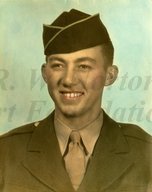
|

|
|
|
|
Ray was born in Magnolia, Arkansas, as one of four children of Taylor France Ford and Lillian Faye Thomas Ford, the eldest of four children. He spent part of his boyhood in Magnolia, where the family resided near his maternal grandparents, Samuel and Albertine Smith Thomas, and their 800-acre cotton farm. The Fords lived in a shotgun house that featured a living room, kitchen, dining area, and back porch. "My grandparents, who lived about a couple hundred yards away, had a big house and I was there a lot," he recalls. He learned to milk cows in his grandparents' diary herd and helped out by picking cotton and driving teams of mules. Near the Thomas home stood a chair factory, owned by his father's brother, where Ray often watched workers turn the lathe and make chairs. "In fact my uncle brought me a set of chairs, what we refer to as Ford chairs," he recalls. "When Mary Lois and I married he brought us a set. I believe it was six chairs and we are still using those chairs today." Ray lived in Magnolia until he was 11 when the family moved to Haynesville, Louisiana, where his father, a minister, was pastor of a Pentecostal church. Two years later in 1936 they moved to Kilgore, Texas, where the elder Ford was pastor of First Pentecostal Church for eight years. During that time he also founded a publishing house for the denomination's literature, where Ray, at 14, began work in a trade he soon came to love. He graduated from Kilgore High School in 1940. "The night I graduated I went to my home and changed clothes and went to the print shop and set type the rest of the night," he recalls. At the publishing house he helped print Sunday School books and hymnals, among other literature. On December 25, 1941 Ray married Mary Lois Camp. (They would have two sons, one granddaughter and one great-granddaughter.) Ray was employed at the publishing house until he entered the U.S. Army Air Forces in April of 1943. He was sent to Camp Wolters near Mineral Wells, Texas, then to Sheppard Field in Wichita Falls, Texas, for basic training. After a brief stint at Buckley Field in Aurora, Colorado, he completed teletype school at Drew Field in Tampa, Florida. At Hattiesburg Army Airfield near Hattiesburg, Mississippi, he was placed in Headquarters Plotting Platoon of Company B, 574th Signal Air Warning Battalion. Trained as a teletype operator, he saw little service in that field. "I went overseas and I saw one teletype overseas on the island of Okinawa," he recalls. Back home, he says Mary Lois worked in the publishing house, running presses among other tasks. In January of 1944 Ray was sent to Camp Pinedale near Fresno, California, in preparation for overseas assignment. He recalls arranging for a room at Mrs. Bernard's Boarding House in Fresno where the couple would stay before he shipped out. They were required, however, to produce their marriage license before they could occupy the room. Mary Lois dutifully brought the certificate with her from Texas. From Camp Stoneman Ray boarded a Norwegian freighter pressed into service as a troop ship for a 29-day voyage in April of 1944. Upon arriving in Finchhaven, New Guinea, his battalion was sent to a holding area for "five or six months," where the men lived in pyramidal, six-man tents. "We were there kind of at the start of the monsoon season and it would rain every day. In fact, the tents rotted over our heads and we had to put up new tents after about four or five months," Ray recalls. Every man, he says, had to take the anti-malaria drug, Atabrine, daily. "They put a pan down and as you'd go by to get your food you had to pick up an Atabrine and take it, and then you could move down the chow line," he recalls. Ray worked in the message center, decoding messages. He saw no hostilities. "Everywhere I went was always secured, so I felt really blessed about that," he says. Ray was transferred to Company B, 595th Signal Battalion on Biak Island. There the men moved into tents formerly occupied by the "Jolly Rogers" of the 90th Bombardment Group. From Biak his battalion was sent to Manila. Soon after the war ended he was among "ten or twelve" men from his unit who flew on a B-29 to Okinawa. He then crossed to the mainland on an LST and was based in Fukuoka, then at Tachikawa Air Field in western Tokyo. In early December he sailed to America aboard the USS Lexington (CV-16), and was discharged at Fort Sam Houston in San Antonio. He arrived in Kilgore by bus on December 26, 1945. When he appeared at his in-laws' home, Mary Lois was sweeping the hall of the dogtrot house. "I came running up and bounded down on the floor and I had her in my arms," he recalls. With his parents moving from Kilgore and the publishing house closed, Ray went to work as a printer and linotype operator at The Kilgore News Herald. He left the newspaper after 13 years to open his own business, Ford Printing Company in Kilgore. He sold the business and retired in 2003. |


